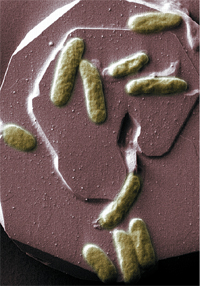Shewanella putrefaciens CN-32 and related species of metal-reducing Shewanella effectively reduce polyvalent metals and radionuclides including solid phase Fe and Mn oxides and DOE relevant contaminants including U(VI), Tc(VII), and Cr(VI). The solubility of these contaminants is greatly diminished at lower oxidation states and hence microbial reduction has been proposed as a means for stabilizing contaminants in situ . Metal-reducing bacteria such as Shewanella and their activities are an area of major emphasis within DOE's Natural and Accelerated Bioremediation Research (NABIR) program. One of the novel aspects of metal-reducing Shewanella is their remarkable capacity to utilize oxidized metals associated with solid phase minerals as electron acceptors during anaerobic respiration. These include a wide range of Fe and Mn oxides as well as structural Fe(III) associated with clay minerals. In spite of considerable effort the mechanistic details of how MRB such as Shewanella are able to establish an efficient connection between their electron transport system solid phase associated metals remain unclear. The sequencing of additional strains of metal-reducing Shewanella , between which there are subtle differences in the ability to reduce various forms of metal oxides, should greatly facilitate a mechanistic understanding of how Shewanella reduces metals. |
||
|
||
Shewanella putrefaciens CN-32

